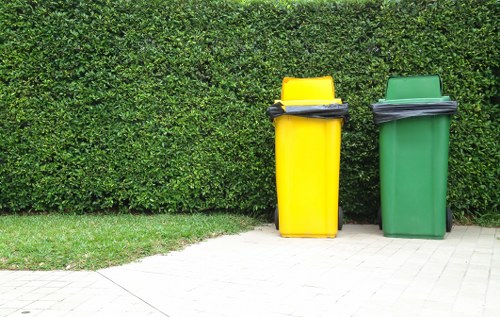Council Large Item Collection in Office Clearance

Understanding Council Large Item Collection
Office clearance often involves the removal of bulky items that regular waste collection services cannot handle. Council large item collection is a service provided by local authorities to help businesses efficiently dispose of large and unwieldy items, ensuring a clutter-free and sustainable workspace.
Efficient office clearance is crucial for maintaining a productive work environment. It not only enhances the aesthetics of the office but also contributes to the overall health and safety of employees by eliminating potential hazards.
Utilizing council large item collection services ensures that large waste items are disposed of responsibly, adhering to local regulations and environmental guidelines.

Benefits of Council Large Item Collection
There are numerous advantages to using council large item collection for office clearance:
- Convenience: Scheduled pickups reduce the hassle of arranging separate disposal methods.
- Cost-Effective: Utilizing council services can be more affordable compared to private disposal companies.
- Environmentally Friendly: Councils often ensure that items are recycled or disposed of in an eco-friendly manner.
- Compliance: Ensures that disposal practices meet local regulations and waste management standards.
These benefits make council large item collection an attractive option for businesses looking to streamline their office clearance processes.
Moreover, leveraging these services can enhance a company’s sustainability profile, which is increasingly important to stakeholders and customers alike.

Types of Items Eligible for Collection
Not all large items are accepted for council collection. Commonly accepted items include:
- Furniture such as chairs, desks, and cabinets
- Electronic appliances like old computers, printers, and monitors
- Office equipment including photocopiers and shredders
- Mattresses and upholstered items
- Large volumes of paper waste
Before scheduling a pickup, it’s essential to check with your local council for a comprehensive list of eligible items and any restrictions that may apply.
Proper categorization and segregation of items can facilitate a smoother clearance process and improve recycling outcomes.

Preparing for Council Collection
Proper preparation is key to ensuring an efficient large item collection. Here are steps to take before the pickup:
- Inventory: Create a detailed list of items to be collected.
- Segregation: Separate recyclable materials from non-recyclable ones.
- Accessibility: Ensure that items are easily accessible for collection and that pathways are clear.
- Scheduling: Book your collection in advance to secure a convenient date and time.
- Compliance: Adhere to any specific guidelines provided by the council regarding item placement and preparation.
By following these steps, businesses can minimize disruptions during office clearance and enhance the overall efficiency of the collection process.
Additionally, communicating with employees about the clearance process can help in organizing items and reducing last-minute complications.

Environmental Impact and Sustainability
One of the significant advantages of council large item collection is its positive environmental impact. Councils typically prioritize recycling and responsible disposal, ensuring that as much material as possible is repurposed or recycled.
By utilizing these services, businesses can contribute to reducing landfill waste and promoting a circular economy. This not only aligns with corporate social responsibility goals but also appeals to environmentally conscious consumers and partners.
Furthermore, proper disposal of electronic waste prevents harmful substances from entering the environment, safeguarding both public health and natural ecosystems.
Steps to Schedule a Collection
Scheduling a council large item collection involves several straightforward steps:
- Visit your local council’s website or contact their waste management department.
- Fill out the required forms, providing details about the items you wish to dispose of.
- Specify the date and time for the collection if the council allows scheduling.
- Ensure that items are prepared and accessible on the scheduled day.
- Confirm the collection details to avoid any misunderstandings.
Early planning and communication with the council can help prevent delays and ensure a smooth clearance process.
It’s also advisable to keep records of the items scheduled for collection, especially for large quantities, to track disposal and recycling effectively.
Cost Considerations
While council large item collection services are often cost-effective, there may be associated fees depending on the volume and type of items. It’s essential to:
- Understand the council’s pricing structure and any potential additional charges.
- Compare costs with private disposal services to determine the best option for your budget.
- Consider long-term savings from efficient clearance and reduced clutter.
In some cases, councils may offer discounts for regular or bulk collections, making it even more economical for businesses with ongoing clearance needs.
Budgeting for office clearance should include these potential costs to ensure financial planning aligns with waste management strategies.
Compliance and Regulations
Adhering to local waste management regulations is crucial during office clearance. Non-compliance can result in fines and environmental harm. Key considerations include:
- Understanding the types of materials that require special handling or disposal.
- Ensuring documentation and permits are in place if needed.
- Following council guidelines for item placement and preparation.
By staying informed about local regulations, businesses can avoid legal issues and promote responsible waste management practices.
Regular training and updates for staff involved in the clearance process can enhance compliance and streamline disposal efforts.
Choosing the Right Time for Clearance
Timing plays a significant role in the efficiency of office clearance. Factors to consider include:
- Business Cycles: Select periods with minimal disruption to daily operations.
- Seasonal Constraints: Avoid peak seasons where council services might be overwhelmed.
- Availability of Storage: Ensure temporary storage solutions are in place if needed.
Strategic scheduling can help mitigate disruptions and ensure that clearance activities are aligned with business priorities.
Additionally, early planning allows for flexibility in case of unexpected delays or changes in the clearance plan.
Maximizing Efficiency in Office Clearance
To maximize efficiency during office clearance:
- Develop a clear plan outlining tasks and responsibilities.
- Assign dedicated teams to manage different aspects of the clearance.
- Utilize checklists to ensure all items are accounted for and properly disposed of.
- Leverage technology for scheduling and tracking disposal activities.
Implementing these strategies can lead to a more organized and expedited clearance process, minimizing downtime and enhancing overall productivity.
Continuous evaluation and improvement of clearance procedures can further optimize efficiency and resource utilization.
Recycling and Donating Unwanted Items
Not all items collected need to be disposed of in landfills. Consider the following options:
- Recycling: Electronic waste, metals, and paper can often be recycled.
- Donating: Gently used furniture and equipment can be donated to charities or non-profit organizations.
- Repurposing: Items can be repurposed within the organization or by employees.
These practices not only reduce environmental impact but also foster a culture of sustainability within the business.
Collaborating with local recycling centers and donation agencies can facilitate the effective reuse of office items.
Common Challenges and Solutions
Office clearance with council large item collection can present several challenges, including:
- Logistical Issues: Coordinating the collection schedule with business operations.
- Volume Management: Handling large quantities of items efficiently.
- Compliance: Ensuring all items meet disposal regulations.
Solutions to these challenges involve meticulous planning, effective communication with the council, and leveraging professional services when necessary.
Investing in training and resources can also help overcome obstacles and ensure a smooth clearance process.
Post-Clearance Activities
After the collection, it’s important to:
- Inspect the cleared area for any remaining items.
- Evaluate the effectiveness of the clearance process.
- Provide feedback to the council for future improvements.
These steps help in maintaining a clutter-free environment and preparing for any future clearance needs.
Additionally, documenting the clearance process can streamline future office clearances and enhance organizational knowledge.
Case Studies: Successful Office Clearances
Numerous businesses have benefited from council large item collection services. For example:
- A medium-sized company successfully cleared outdated electronics, enhancing office safety and efficiency.
- A law firm utilized the service to remove old furniture, creating a more modern and welcoming workspace.
- A startup managed extensive office clearance with minimal disruption, facilitating a smooth relocation process.
These case studies illustrate the practical advantages of utilizing council large item collection in office clearance.
Learning from these examples can guide businesses in planning and executing their own clearance projects effectively.
Future Trends in Office Clearance
The landscape of office clearance is evolving with trends such as:
- Increased Automation: Use of technology to streamline scheduling and tracking.
- Sustainability Focus: Greater emphasis on recycling and reducing environmental impact.
- Customized Services: Tailored clearance solutions to meet specific business needs.
Staying abreast of these trends can help businesses adapt and enhance their office clearance strategies.
Adoption of innovative practices ensures that office clearance remains efficient, cost-effective, and environmentally responsible.
Final Thoughts on Council Large Item Collection
Council large item collection is an invaluable service for businesses undertaking office clearance. It offers a balance of convenience, cost-effectiveness, and environmental responsibility, making it an optimal choice for managing bulky waste items.
By leveraging these services, businesses can maintain a clean and organized workspace, comply with local regulations, and contribute to sustainable waste management practices.
Contact us today to learn more about how council large item collection can streamline your office clearance needs.